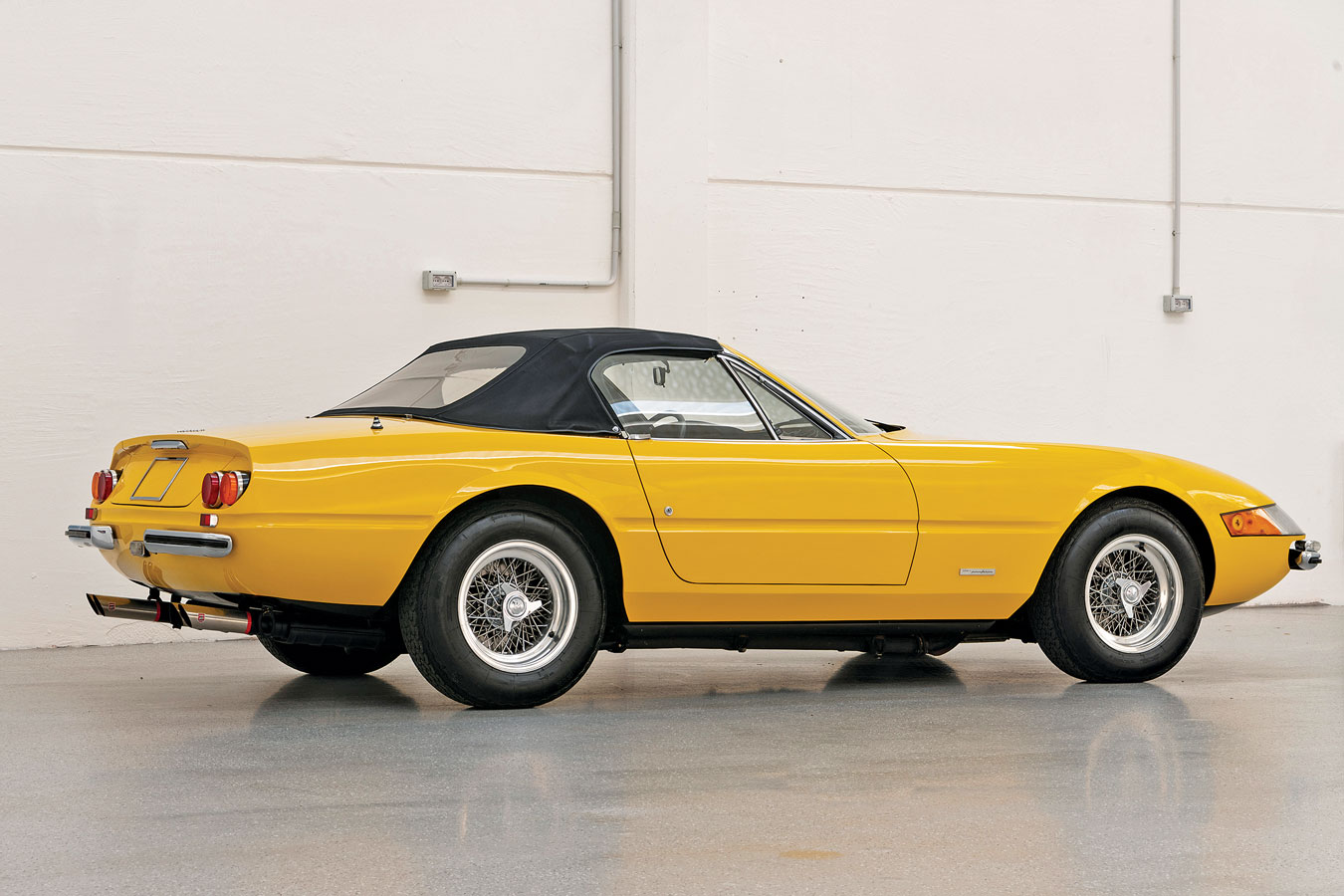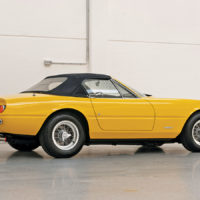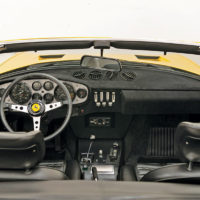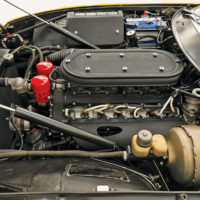SCM Analysis
Detailing
| Vehicle: | 1973 Ferrari 365 GTS/4 Daytona Spider |
| Years Produced: | 1969–73 |
| Number Produced: | 122 |
| SCM Valuation: | $2,191,500 |
| Tune Up Cost: | $3,000 |
| Chassis Number Location: | Stamped in the frame above right-front spring mount |
| Engine Number Location: | Below head on rear passenger’s side of block |
| Club Info: | Ferrari Club of America |
| Website: | http://www.FerrariClubofAmerica.org |
| Alternatives: | 2000 Ferrari 550 Barchetta, 1969 Aston Martin DB6 Volante, 1971 Maserati Ghibli SS 4.9 Spyder |
| Investment Grade: | A |
This car, Lot 164, sold for $2,692,311 (€2,592,500), including buyer’s premium, at RM Sotheby’s Monaco auction on May 14, 2022.
Thanks to a popular movie, more Americans know that Ford beat Ferrari at Le Mans than know which country Le Mans is in. What they don’t realize is that following Ford’s impressive run of victories, Ferrari spanked Ford with a 1-2-3 sweep of the 1967 Daytona 24-hour race. A newly introduced Ferrari 330 P4 prototype crossed the line first, followed up by another 330 P4 and then a 330 P3 upgraded to P4 specs. There’s an iconic photo of the three cars crossing the finish line with the Daytona logo on the wall behind them. It is this moment that minted the Ferrari Daytona nickname.
What’s in a name?
The finish was a proud moment for Ferrari and one of the most important victories in the company’s history. Legend has it that Enzo Ferrari wanted to commemorate the event by naming his next production car after the victory. A new 12-cylinder GT car was in gestation at the time and the project’s codename became Daytona.
The Daytona moniker was leaked prior to the introduction of the model, and with the surprise outed, Enzo Ferrari canceled the name in favor of the traditional Ferrari nomenclature. The Daytona became the 365 GTB/4, designating it as a 365-cc-per-cylinder, 12-cylinder grand-touring berlinetta with a 4-cam engine. With no fewer than 14 different 365 models in the Ferrari lineup, the Daytona codename offered the 365 GTB/4 an individual identity, and it stuck.
In 1969, Ferrari introduced a drop-top version of the Daytona. Officially known as the 365 GTS/4, it was better known unofficially as the Daytona Spyder. Years later, Ferrari CEO Luca de Montezemolo made it clear that he despised the spelling of “spyder,” and now most official references to open-top Ferraris are spelled in the correct fashion.
Sawzall spiders
A roof is a structural member of most cars, and cutting it off reduces rigidity. Modifying the Daytona to an open-top configuration required significant strengthening of the body. Ferrari accomplished that by replacing the fiberglass inner fender panels in the engine compartment with metal panels and adding extra metal in the rocker area.
Converting a Daytona coupe to a spider became a popular project in the 1980s. Most conversions were not budgeted to make an undetectable copy. Fiberglass inner-fender panels are a giveaway that a spider is a conversion. A rear-window defogger switch in a car that doesn’t have a glass rear window is another telltale sign.
From ragtops to riches
Most followers of Ferrari know that even 250 GTOs and 250 GT California Spiders were once merely last year’s hot cars, irreverently replaced with a newer offering. In period, they could be purchased for under $10,000. Before these classics were worth more than an apartment complex, the Daytona Spider led the charge of Ferraris morphing from disposable automobiles into trophies for the rich.
Ferrari old-timers tell stories of new Daytona Spiders languishing in showrooms well past their sell-by date. Exciting new models from Lamborghini, DeTomaso, Bizzarrini, Iso and even Toyota were grabbing the attention of both the automotive press and exotic-car buyers. Daytonas were discounted for being old technology.
In the late ’80s, a couple of enterprising dealers juiced the Daytona Spider market by cross-trading a Daytona Spider and escalating the price with each trade. It’s unlikely they ever sold the car at their hyped $1,000,000 value, but over the next few years the popularity and value of the car did actually rise.
Despite a slow start, Daytona Spiders became the must-have Ferrari in the ’80s. Similar to any serious current Ferrari collection that requires a row of supercars, any ’80s collection needed to have a Daytona Spider in the mix. They became blue-chip collectibles, commanding more money with each new transaction.
It’s difficult to overstate the desirability of the Daytona Spider in-period. The list of a few past owners of chassis 16839 gives a hint to the model’s power. Besides being serious Ferrari collectors, these guys made their mark on the world. Beeper pioneer Dean Becker, Sir Anthony Bamford (of JCB equipment), Otis Chandler (publisher of The Los Angeles Times), and Joel Finn (computer pioneer and automobile author) all owned 16839, as did my friend and fellow SCMer David Bruno.
A changing market
In 2007, an extraordinary Daytona Spider fetched over $2m at auction, nearly a million dollars over the then-current market. Soon million-dollar-plus sales were commonplace. By 2014, it took $2m–$3m to buy a great example. Since then, the values have been stagnant at closer to the $2m range.
The allure of the Daytona Spider has faded. Hard-to-get and limited-edition Ferraris like the F40, 550 Barchetta and 599 GTO have siphoned the attention of Ferrari collectors. Filling a garage with Ferrari’s contemporary instant collectibles has become the measure of today’s Ferrari collector. Half-century-old Ferraris just don’t have the same cachet.
RM Sotheby’s $2,698,793 sale of chassis 16839 is the highest auction sale of a Daytona Spider in nearly seven years. The result is not surprising, as the car has a well-known provenance and Classiche certification. What is surprising, though, is while the value of models like manual F430s have jumped in breathtaking numbers, this sale hardly moves the needle of the Daytona Spider’s value.
Our subject Ferrari is a 49-year-old car. The 20-year-old who lusted after a Daytona Spider when they were new is now around 70 years old. They have either owned one already or never will.
While a Daytona Spyder is special enough to make the want list of younger collectors, these collectors show little interest in less-desirable vintage models. The seller picked a good time to get out. The buyer made a financial gamble but got one of the most coveted cars in the Ferrari world. Neither should be disappointed. ♦
(Introductory description courtesy of RM Sotheby’s.)



